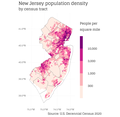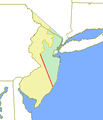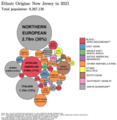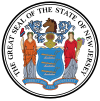Portal:New Jersey
The New Jersey Portal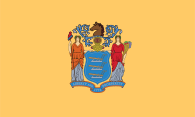 New Jersey is a state situated within both the Mid-Atlantic and Northeastern regions of the United States. It is the most densely populated of all 50 U.S. states, and is situated at the center of the Northeast megalopolis. New Jersey is bordered on its north and east by New York state; on its east, southeast, and south by the Atlantic Ocean; on its west by the Delaware River and Pennsylvania; and on its southwest by Delaware Bay and Delaware. At 7,354 square miles (19,050 km2), New Jersey is the fifth-smallest state in land area, but with close to 9.3 million residents as of the 2020 United States census, its highest decennial count ever, it ranks 11th in population. The state capital is Trenton, and the state's most populous city is Newark. New Jersey is the only U.S. state in which every county is deemed urban by the U.S. Census Bureau with 13 counties included in the New York metropolitan area, seven counties in the Philadelphia metropolitan area, and Warren County part of the heavily industrialized Lehigh Valley metropolitan area. New Jersey was first inhabited by Paleo-Indians as early as 13,000 B.C.E., with the Lenape being the dominant Indigenous group when Europeans arrived in the early 17th century. Dutch and Swedish colonists founded the first European settlements in the state, with the British later seizing control of the region and establishing the Province of New Jersey, named after the largest of the Channel Islands. The colony's fertile lands and relative religious tolerance drew a large and diverse population. New Jersey was among the Thirteen Colonies that supported the American Revolution, hosting several pivotal battles and military commands in the American Revolutionary War. On December 18, 1787, New Jersey became the third state to ratify the United States Constitution, which granted it admission to the Union, and it was the first state to ratify the U.S. Bill of Rights on November 20, 1789. (Full article...) Selected article -
The Darlington's Bridge at Delaware Station was a highway bridge over the Delaware River in the community of Delaware, New Jersey (known locally as Delaware Station). Formerly a railroad bridge constructed by the Delaware, Lackawanna and Western Railroad in 1855, the bridge was sold off when the new one upstream was constructed. Henry V. Darlington, an Episcopal minister in Delaware and nearby Belvidere offered to buy the second-hand bridge for $5,000 (1914 USD, equal to $152,093 today). Darlington converted it into a highway bridge, using two fired members of the nearby Meyer's Ferry to be toll collectors. The bridge prospered, becoming a part of State Highway Route 6 in 1927 and U.S. Route 46 in 1936. In 1932, during the massive state takeover of bridges by the Delaware River Joint Toll Bridge Commission, Darlington refused offers, bargaining his way up to $275,000 (1932 USD, equal to $6,141,220 today) before accepting the sale. This amount was a far cry from the nearby Belvidere-Riverton and Portland-Columbia Covered Bridge, which were accepted for $60,000 (equal to $1,339,902 today) and $50,000 (equal to $1,116,585 today) respectively. On that moment, tolls along the bridge and Route 6 were eliminated. The bridge prospered toll-free for another 21 years, until the construction of the Portland-Columbia Toll Bridge upstream at Columbia. Although Reverend Darlington was still alive to see all this transpire, the Commission ceased operations on the Darlington Bridge on April 3, 1954, and the bridge was immediately demolished.
Selected picture - Credit: AEMoreira042281 The Newark Light Rail is a light rail system operated by NJ Transit serving Newark. The service is made up of two segments, the Newark City Subway and the Broad Street Extension. New Jersey news'Related portalsSelected biography - Stephen Grover Cleveland (March 18, 1837 – June 24, 1908) was an American politician who served as the 22nd and 24th president of the United States from 1885 to 1889 and from 1893 to 1897. He is the only president in U.S. history to serve non-consecutive presidential terms. In the years before his presidency, he served as a mayor and as governor of New York state, winning fame as an anti-corruption crusader. Cleveland was the first Democrat to win the presidency after the Civil War, and was one of two Democratic presidents, followed by Woodrow Wilson in 1912, in an era when Republicans dominated the presidency between 1869 and 1933. He won the popular vote in three presidential elections—1884, 1888, and 1892. Benjamin Harrison won the electoral college vote, and thus the presidency, in 1888. Cleveland was elected mayor of Buffalo in 1881 and governor of New York in 1882. While governor, he closely cooperated with state assembly minority leader Theodore Roosevelt to pass reform measures, winning national attention. He led the Bourbon Democrats, a pro-business movement opposed to high tariffs, free silver, inflation, imperialism, and subsidies to business, farmers, or veterans. His crusade for political reform and fiscal conservatism made him an icon for American conservatives of the time. Cleveland also won praise for honesty, self-reliance, integrity, and commitment to the principles of classical liberalism. His fight against political corruption, patronage, and bossism convinced many like-minded Republicans, called "Mugwumps", to cross party lines and support him in the 1884 election. Fifteen months into his first presidential term, he married Frances Folsom on June 2, 1886. After losing the 1888 election to Harrison, he moved to New York City with his wife and joined a law firm. At the 1892 Democratic National Convention, he won the nomination on the first ballot, and the 1892 election restored him to the White House. As his second administration began, the Panic of 1893 sparked a severe national depression. Many voters blamed the Democrats, opening the way for a Republican landslide in 1894 and for the agrarian and silverite seizure of the Democratic Party in 1896. This led to a political realignment that started the Fourth Party System and the Progressive Era. An anti-imperialist, Cleveland opposed the push to annex Hawaii, launched an investigation into the 1893 coup against the Hawaiian queen, and called for her to be restored; the House of Representatives adopted a resolution against annexation. (Full article...)Did you know? -
General imagesThe following are images from various New Jersey-related articles on Wikipedia.
TopicsQuality content
CategoriesThings you can do
For more information on how you can help, see the WikiProject New Jersey. Associated WikimediaThe following Wikimedia Foundation sister projects provide more on this subject:
Discover Wikipedia using portals |








